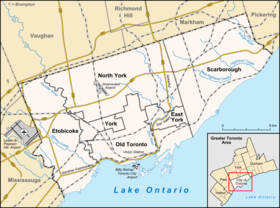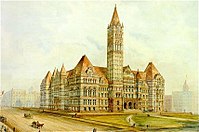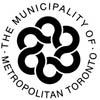Metropolitan Toronto | |
|---|---|
Dissolved region | |
| Municipality of Metropolitan Toronto | |
 | |
|
| |
| Nickname(s): Metro, Metro Toronto | |
 Location of Metropolitan Toronto in Greater Toronto Area | |
| Country | Canada |
| Province | Ontario |
| Incorporated | 1953 from York County |
| Dissolved | 1998 into Toronto |
| Government | |
| • Type | Council–manager government |
| • Body | Metropolitan Toronto Council |
| • Chairman | Alan Tonks (last) |
| Area | |
| • Total | 630 km2 (240 sq mi) |
| Time zone | UTC−05:00 (EST) |
| • Summer (DST) | UTC−04:00 (DST) |
| History of Toronto | ||||||||||||||||
|---|---|---|---|---|---|---|---|---|---|---|---|---|---|---|---|---|
 | ||||||||||||||||
| History | ||||||||||||||||
|
||||||||||||||||
| Events | ||||||||||||||||
|
||||||||||||||||
| Other | ||||||||||||||||
|
| ||||||||||||||||
The Municipality of Metropolitan Toronto was an upper-tier level of municipal government in Ontario, Canada, from 1953 to 1998. It was made up of the old city of Toronto and numerous townships, towns and villages that surrounded Toronto, which were starting to urbanize rapidly after World War II. It was commonly referred to as "Metro Toronto" or "Metro".
Passage of the 1997 City of Toronto Act caused the 1998 amalgamation of Metropolitan Toronto and its constituents into the current City of Toronto. The boundaries of present-day Toronto are the same as those of Metropolitan Toronto upon its dissolution: Lake Ontario to the south, Etobicoke Creek and Highway 427 to the west, Steeles Avenue to the north, and the Rouge River to the east.

